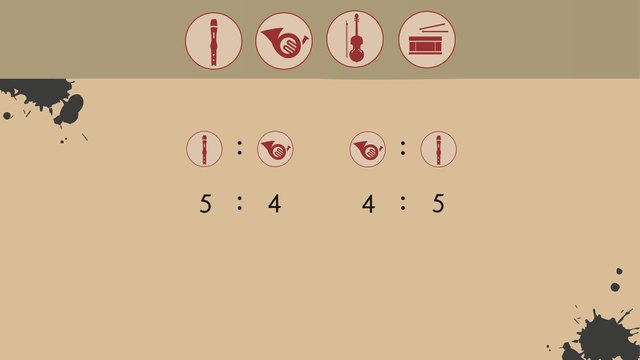Associated Ratios and the Value of a Ratio


Basics on the topic Associated Ratios and the Value of a Ratio
After this lesson, you will be able to derive associated ratios from a given ratio.
The lesson begins by reviewing that ratios can be written with colons and as fractions. It leads you to learn that associated ratios are ratios that can be found from a given ratio or information. It concludes by reminding you that the order of writing any ratio matters and that is best to write a ratio in its simplest or reduced form.
Learn about associated ratios by watching Preston Waltz conduct his orchestra.
This video includes key concepts, notation, and vocabulary such as associated ratios, which are ratios that can be found from a given ratio.
Before watching this video, you should already be familiar with ratios and simplifying fractions.
After watching this video, you will be prepared to learn about ratio tables and double number lines and eventually solve percent problems.
Common Core Standard(s) in focus: 6.RP.A.3.A A video intended for math students in the 6th grade Recommended for students who are 11 - 12 years old
Transcript Associated Ratios and the Value of a Ratio
Meet Preston Leopold Waltz, the world’s foremost orchestral composer. Not only does he decide how many of each instrument family make up his orchestra, he also orchestrates the orchestras he orchestrates. Preston, as he’s known in the classical music world, always comes up with the perfect ratio of woodwinds to brass, to strings, to percussion. To better understand Preston’s genius, let’s take a look at associated ratios and their values. For the perfect sounding orchestra, Preston chooses 5 woodwind instruments, 4 brass, 20 strings and 1 percussion instrument. Let's take a look at the different ratios of instruments to help us better understand Preston's musical genius. One ratio we can see is the number of woodwinds to the number of brass instruments. This can be written as 5 to 4. But how many brass to woodwind instuments are there? We can find it by using the associated ratio. 4 brass to 5 woodwinds. These ratios are associated because they are related to one another. This means, given one ratio, we can find the other. But, as you can see, the order in which we write the ratio makes a difference. Ratios can be written in fraction form as well. The first number always becomes the numerator and the second always becomes the denominator. But let’s say we have a different mixture of instruments: like brass instruments to stringed instruments. We already know two ways of writing ratios: with a colon or as a fraction. If we replace these icons with their respective numbers, as we did before, we get the same ratio expressed in two ways! We can read this as 4 brass to 20 stringed instruments, or for every 4 brass instruments in the orchestra, there are 20 stringed instruments. Since one of the ratios is written as a fraction, you might be thinking that we can reduce ratios, just like a fraction, and you’d be correct! When expressing ratios, it’s always good to express them in the most reduced form, just like a fraction. How do we do that? First, we have to look for the greatest common factor of 4 and 20. In this case, the GCF is 4. Just like when reducing a fraction, we have to divide both sides by 4, giving us the ratio 1 to 5. Are there other associated ratios we can find with our given information? What about expressing a family of instruments to the orchestra as a whole? That’s no problem! Let’s see how many woodwinds there are compared to the total number of instruments in the orchestra. We know how many woodwinds there are, 5. So, to find the total we sum all the instruments in the orchestra. Since we have 5 woodwinds, 4 brass, 20 stringed instruments and 1 percussion, we have a total of 30 instruments in the orchestra, giving us a final ratio of 5 to 30. But wait! Don’t leave it like that! You must reduce the ratio to its simplest form by canceling out the greatest common factor! What's the GCF of 5 and 30? 5! So, dividing both sides by 5, we get our final ratio of 1 to 6. Which means 1 out of every 6 instruments is a woodwind. Could we find out how many instruments are NOT woodwinds? We can subtract 6 minus 1, since 6 represents total instruments and 1 represents the woodwind. This means 5 are NOT woodwinds. Therefore, we can write the associated ratio of 5 out of every 6 intruments are NOT woodwinds. To review associated ratios… Remember that ratios can be written different ways: with a colon and as a fraction. Associated ratios are the ratios that can be found from the given ratios or information. We must always remember to write ratios in their simplest form, and don't forget the order in which you present the ratio matters! Let’s get back to our maestro, Preston Leopold Waltz. He’s once again constructed his orchestra with the perfect ratio of instruments. What a performance! Take a bow, Preston!
Associated Ratios and the Value of a Ratio exercise
-
Find the associated ratio for each given ratio.
HintsThe ratio $1$ to $2$ can be written as $1:2$ or $\frac{1}{2}$.
The numbers in a ratio can be used to form different ratios, which are called associated ratios.
Two associated ratios for $\frac{1}{4}$ are $4:1$ and $4:3$.
SolutionAssociated ratios are related to one another. This means that given one ratio, we can find the other.
$5$ to $1$ is associated with $\frac{1}{5}$
- The numbers in the ratio are switched.
- Simplify $\frac{9}{12}$ by dividing both numbers by $3$ yields $\frac{3}{4}$.
- $\frac{3}{4}$ is associated with $4:3$.
- Since $7-1=6$, $6:7$ is associated with $1$ to $7$.
- Simplify $\frac{18}{4}$ by dividing both numbers by $2$ yields $\frac{9}{2}$.
- $\frac{9}{2}$ is associated with $\frac{18}{4}$.
- Simplify $6:10$ by dividing both numbers by $2$ yields $3:5$.
- $3:5$ is associated with $6:10$.
- Simplify $11:22$ by dividing both side by $11$ yields $1:2$.
- $1:2$ is associated with $\frac{1}{2}$.
-
Write each sentence in ratio notation.
HintsEquivalent ratios can be found either by simplifying both sides using the GCF, or by multiplying both sides by a number.
There are two string instruments for every four percussion instruments.
- The ratio is $2:4$ or $\frac{2}{4}$
- If you divide both numbers by $2$, the ratio becomes $1:2$ or $\frac{1}{2}$.
You can also multiply the ratio $1:2$ or $\frac{1}{2}$ by a number to find an equivalent ratio.
- If you multiply both numbers by $3$, the ratio becomes $3:6$ or $\frac{3}{6}$.
Solution1. There are five string instruments for every three brass instruments.
- The ratio is written as $5:3$ or $\frac{5}{3}$, which equals $\frac{10}{6}$.
- If you multiply both numbers in the ratio $\frac{5}{3}$ by $2$, the ratio becomes $\frac{10}{6}$.
- The ratio is written as $4:1$ or $\frac{4}{1}$, which equals $\frac{12}{3}$.
- If you multiply both numbers in the ratio $\frac{4}{1}$ by $3$, the ratio becomes $\frac{12}{3}$.
- The ratio is written as $3:2$ or $\frac{3}{2}$.
- If you multiply both numbers in the ratio $3:2$ by $2$, the ratio becomes $6:4$.
- If you multiply both numbers in the ratio $\frac{3}{2}$ by $3$, the ratio becomes $\frac{12}{8}$.
- The ratio is written as $2:5$ or $\frac{2}{5}$, which equals $\frac{6}{15}$.
- If you multiply both numbers in the ratio $\frac{2}{5}$ by $3$, the ratio becomes $\frac{6}{15}$.
- The ratio is written as $2:8$ or $\frac{2}{8}$.
- If you divide both numbers by two, the ratios become $1:4$ and $\frac{1}{4}$.
- If you multiply both numbers in the ratio $\frac{1}{4}$ by $3$, the ratio becomes $\frac{3}{12}$.
- The ratio is written as $6:3$ or $\frac{6}{3}$.
- If you divide both numbers by $3$, the ratios become $2:1$ and $\frac{2}{1}$.
- If you multiply both numbers in the ratio $\frac{2}{1}$ by $2$, the ratio becomes $\frac{4}{2}$.
-
Identify which statements are true.
Hints$4:1$, $\frac{4}{1}$, and $4$ to $1$ are three ways of representing a ratio.
If there are three apples to two bananas, the ratio can be written as $3:2$.
If there are three apples to two bananas, the associated ratio can be written as $2:3$.
SolutionTrue Statements:
An associated ratio can be formed from the numbers of a ratio.
- For example, the numbers in the ratio $3:2$ can be switched to write the associated ratio $2:3$.
- If you divide both numbers by $2$, the ratio $4:8$ equals $2:4$.
- If there are $5$ girls for every $3$ boys, the ratio $5$ to $3$ compares the values of girls to boys.
- If you divide both numbers by $2$, $\frac{4}{10}$ equals $\frac{2}{5}$. Switching the numbers in the ratio yields the associated ratio $\frac{5}{2}$.
- Since $7-5=2$, the ratio $2:7$ is an associated ratio for $5:7$.
The ratio $3:8$ is equal to $8:3$.
- $8:3$ is an associated ratio to $3:8$ but they are not equal. This is because order matters in a ratio. Comparing the values $3$ to $8$ is very different from comparing the values of $8$ to $3$.
- Associated ratios are not always equal because they can be formed by rearranging numbers in a ratio. For example, $\frac{1}{9}$ is not equal to the associated ratio $\frac{9}{1}$.
- If you divide both numbers by $2$, $\frac{2}{10}$ equals $\frac{1}{5}$, which does not equal the associated ratio, $\frac{5}{1}$.
-
Identify the ratio which is being described along with its associated ratio.
HintsA ratio is a relation between two quantities.
An associated ratio can be formed from the quantities of another ratio.
An artist uses four yellow tubes of paint for every one red tube of paint.
- The ratio for yellow tubes to red tubes is $4:1$ or $\frac{4}{1}$.
- The associated ratio for yellow tubes to red tubes is $1:4$ or $\frac{1}{4}$.
SolutionA ratio is a relation between two amounts.
An associated ratio can be formed from the quantities of another ratio.
1. Rachel went to the grocery store and bought five bananas for every two apples.
- The ratio of bananas to apples is $5:2$ or $\frac{5}{2}$.
- The associated ratio of apples to bananas is $2:5$ or $\frac{2}{5}$.
- The ratio of strawberries to blueberries is $3:4$ or $\frac{3}{4}$.
- The associated ratio of blueberries to strawberries is $4:3$ or $\frac{4}{3}$.
- The ratio of boys to girls is $6:5$ or $\frac{6}{5}$.
- The associated ratio of girls to boys is $5:6$ or $\frac{5}{6}$.
- The ratio of sunny days to rainy days is $3:1$ or $\frac{3}{1}$.
- The associated ratio of rainy days to sunny days is $1:3$ or $\frac{1}{3}$.
- The ratio of sunflowers to feet is $7:3$ or $\frac{7}{3}$.
- The associated ratio of feet to sunflowers is $3:7$ or $\frac{3}{7}$.
-
Write each fraction in ratio notation.
HintsA ratio written in fraction notation is the same as a ratio written in ratio notation.
Both ways of representing the ratio, $1:2$ and $\frac{1}{2}$, are read "one to two".
The ratio notation for $\frac{7}{3}$ is $7:3$.
SolutionA ratio written in fraction notation is the same as a ratio written in ratio notation.
The numerator always corresponds to the left side of a ratio, and the denominator always corresponds to the right side of a ratio.
1. The ratio notation for $\frac{3}{2}$ is $3:2$.
2. The ratio notation for $\frac{7}{3}$ is $7:3$.
3. The ratio notation for $\frac{1}{9}$ is $1:9$.
4. The ratio notation for $\frac{11}{7}$ is $11:7$.
5. The ratio notation for $\frac{5}{19}$ is $5:19$.
6. The ratio notation for $\frac{8}{3}$ is $8:3$.
-
Determine the ratio and its associated ratio.
HintsA ratio is a relation between two amounts.
An associated ratio can be formed from the quantities of another ratio.
Remember to always simplify your ratios.
A farmer owns ten cows, eighteen chickens and seven goats.
- The ratio of cows to chicken and goats is $10:25$ or $\frac{10}{25}$ which simplifies to $2:5$ or $\frac{2}{5}$.
- The associated ratios of cows to all of the animals is $10:36$ or $\frac{10}{36}$ which simplifies to $5:18$ or $\frac{5}{18}$.
SolutionA ratio is a relation between two amounts, and an associated ratio can be formed from the quantities of another ratio.
Remember to always simplify your ratios and that order matters!
1. Johann is making cookies. The recipe requires two eggs, three cups of flour, and one cup of sugar.
- The ratio of eggs to the total number of ingredients is $2:6$ or $\frac{2}{6}$, which simplifies to $1:3$ or $\frac{1}{3}$.
- The associated ratio of the total number of ingredients to everything but eggs is $6:4$ or $\frac{6}{4}$, which simplifies to $3:2$ or $\frac{3}{2}$.
- The ratio of pianos and clarinets to the remaining instruments is $4:10$ or $\frac{4}{10}$, which simplifies to $2:5$ or $\frac{2}{5}$.
- The associated ratio of flutes and violins to the remaining instruments is $10:4$ or $\frac{10}{4}$, which simplifies to $5:2$ or $\frac{5}{2}$.
- The ratio of boys to girls is $8:15$ or $\frac{8}{15}$.
- The associated ratio of girls to the total number of friends coming to the party is $15:23$ or $\frac{15}{23}$.
- The ratio of basketball to soccer and tennis is $4:9$ or $\frac{4}{9}$.
- The associated ratio of basketball to all three sports is $4:13$ or $\frac{4}{13}$.


















